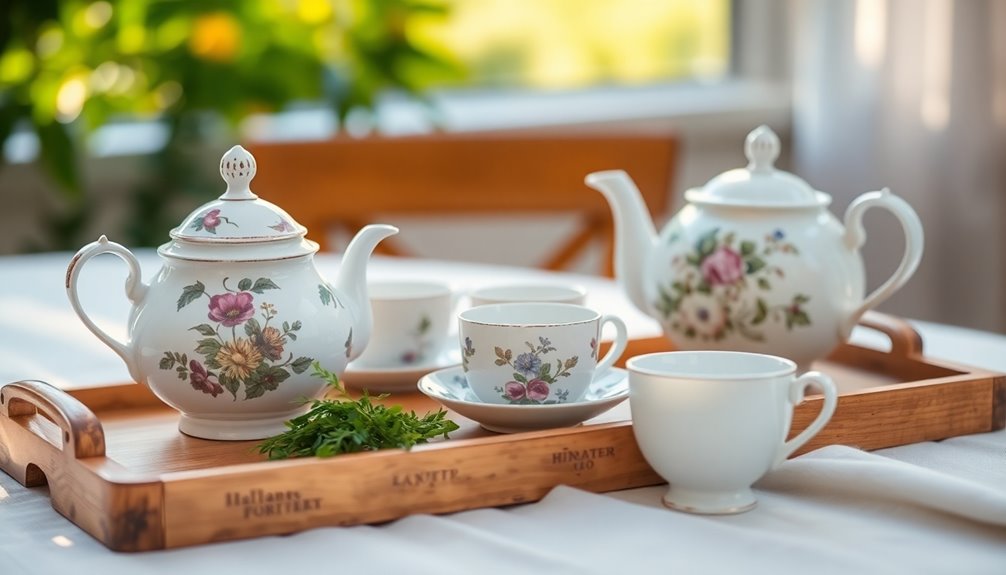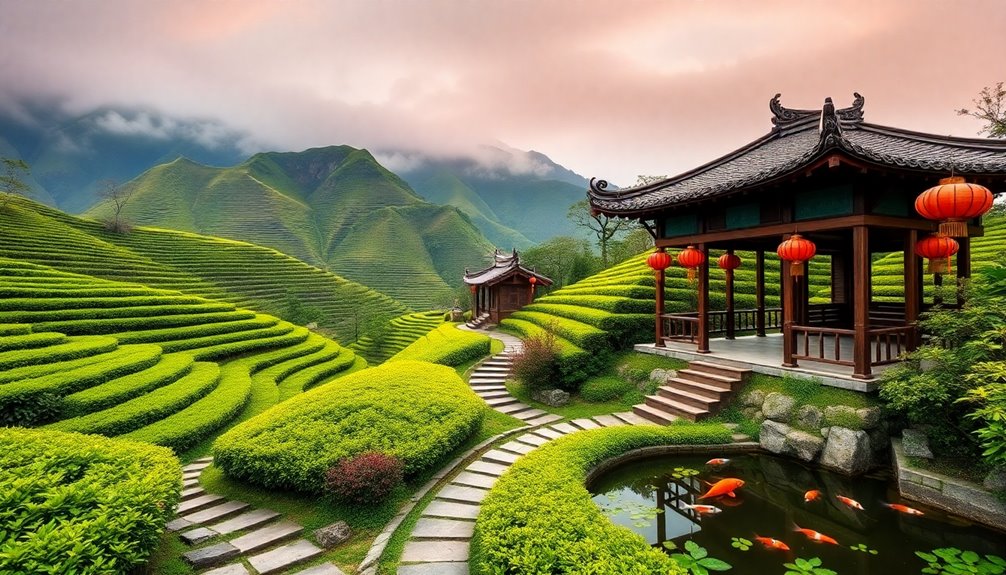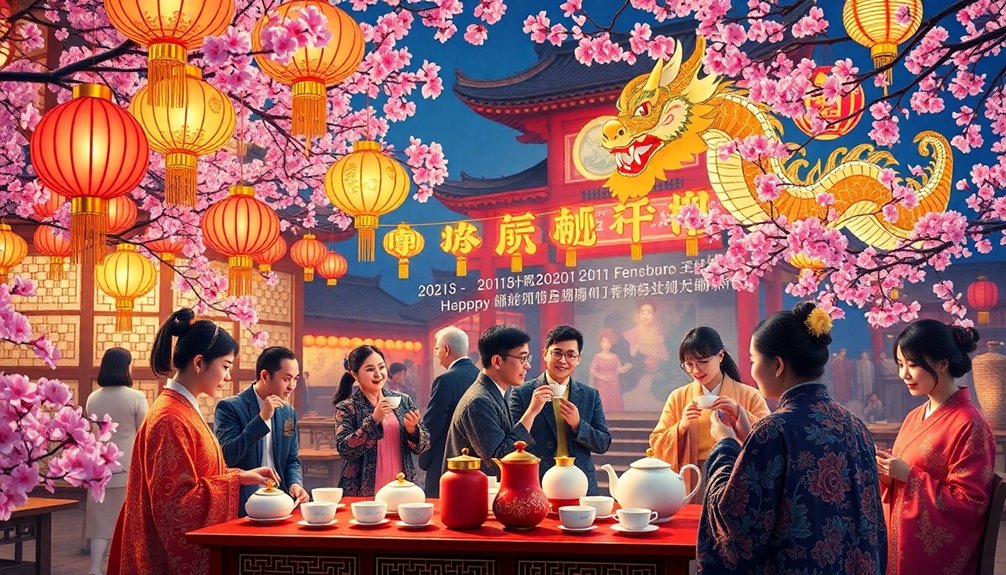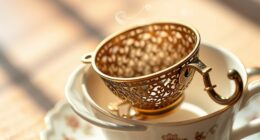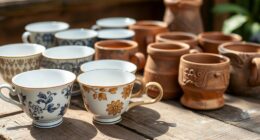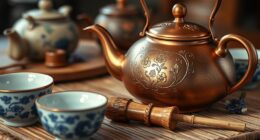Tea isn't just a drink in Chinese culture; it's a symbol of connection and reflection. You'll find it celebrated in Tang dynasty poetry, where poets like Lu Tong wrote about its role in friendship and introspection. Art also embraces tea, with visual depictions highlighting its beauty during ceremonies. The intricate preparation and deep-rooted traditions inspire many artists. Throughout history, tea has served as a muse, blending social interaction with spiritual contemplation. By exploring these themes, you see just how essential tea is to Chinese heritage, revealing even more fascinating aspects of its influence on literature and art.
Key Takeaways
- Tea has been a symbol of tranquility and reflection in Chinese poetry since the Tang dynasty, influencing themes of friendship and social gatherings.
- Lu Yu's *The Classic of Tea* emphasizes tea's cultural significance, merging literary and artistic expressions surrounding tea preparation and consumption.
- Poets like Lu Tong and Li Bai used tea to explore deeper themes of introspection and harmony with nature, enriching Chinese literary heritage.
- Visual arts, such as paintings of tea competitions, illustrate the aesthetic appreciation of tea, showcasing craftsmanship and cultural rituals.
- Modern interpretations of tea culture risk cultural appropriation, emphasizing the importance of understanding and respecting its historical and artistic roots.
Introduction
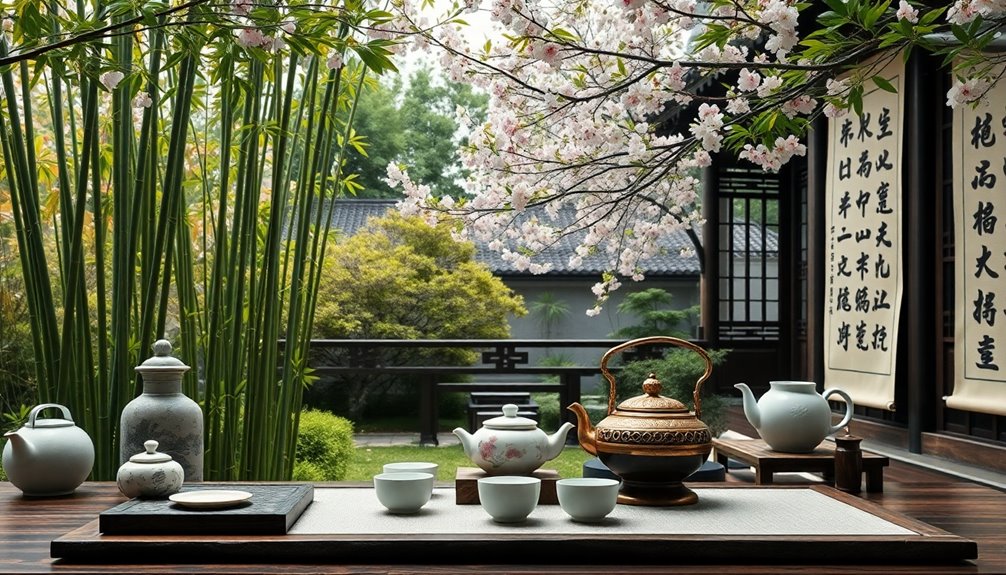
Tea has played a vital role in Chinese culture for over a thousand years, influencing not just daily life but also literature and art. Since the Tang dynasty, tea has emerged as a recurring theme in poetry, where it symbolizes tranquility and reflection. Poets like Li Bai and Du Fu wove tea into their works, highlighting its significance in fostering a contemplative atmosphere.
The 8th-century text, *The Classic of Tea* by Lu Yu, not only serves as the oldest known guide to tea but underscores its cultural importance and the aesthetics of tea preparation.
Artistic representations of tea drinking flourished during this time, with painters like Zhou Fang capturing the leisure and social aspects of tea ceremonies among the nobility.
As we move into the Song dynasty, tea competitions became a vibrant expression of skill and artistry, celebrated in works like Yan Liben's "Tea Competition." These artistic endeavors reflect the deep cultural significance of tea in daily life.
From poetry to painting, tea's presence in Chinese art illustrates its enduring impact, shaping social interactions and enriching the cultural heritage that continues to thrive today.
Tea in Tang Dynasty Poetry
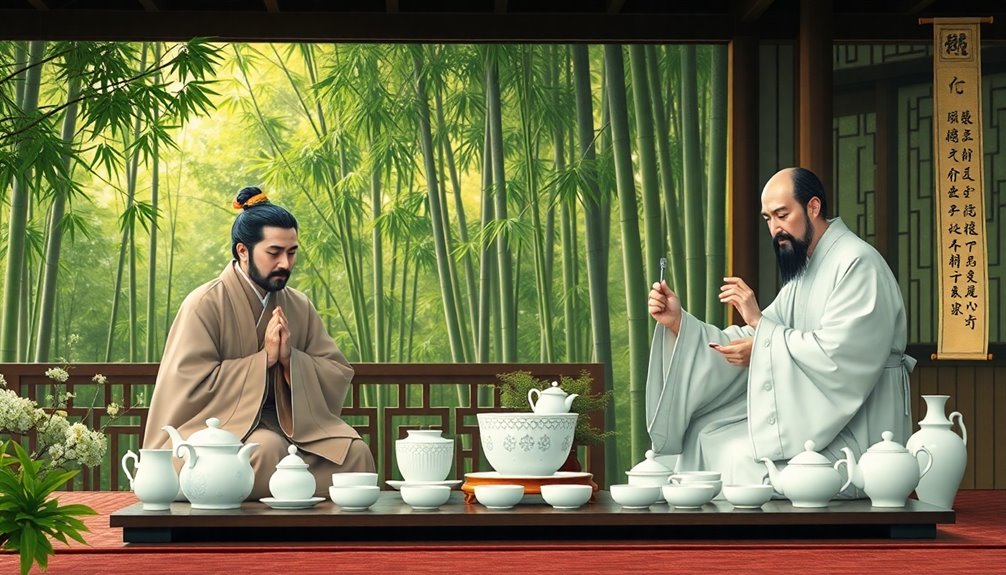
During the Tang dynasty, poetry flourished as a medium to celebrate the cultural refinement and leisure associated with tea. This era marked the peak of tea culture, where poets like Lu Tong and Li Bai weaved the essence of tea into their verses. Through their poetry, they highlighted tea as a symbol of friendship, tranquility, and an invitation to social gatherings.
Lu Tong's "The Song of Tea" exemplifies this appreciation, showcasing how tea enhances personal reflection and camaraderie among friends.
Tea wasn't just a beverage; it sparked creativity and served as a muse for many artists. The aesthetic appreciation of tea encouraged the development of rituals surrounding its preparation and consumption, reinforcing its significance in everyday life.
Poets embraced tea not only for its taste but for the moments it fostered—quiet conversations and shared laughter. In the Tang dynasty, poetry became a canvas for expressing the beauty of tea culture, intertwining elements of nature, social interaction, and spiritual reflection.
Through these literary works, the profound impact of tea on Chinese society was immortalized, illustrating its role as a catalyst for creativity and connection.
Symbolism of Tea in Poetry

In the realm of Chinese poetry, the symbolism of tea transcends its identity as merely a beverage, embodying deeper themes of introspection and connection. Since the Tang dynasty, poets like Li Bai and Du Fu have used tea to evoke feelings of nostalgia and tranquility, often intertwining it with the beauty of nature.
You'll find that the act of drinking tea represents a moment of reflection, symbolizing harmony between the self and the universe.
Lu Tong, a notable Tang dynasty poet, celebrated tea's aesthetic and meditative qualities in his poem "The Tea." His work reflects the artistic admiration for tea, elevating it beyond a simple drink.
Additionally, poetry often highlights tea competitions and gatherings, showcasing the social aspects of tea culture and the craftsmanship involved in tea preparation.
Moreover, tea embodies themes of friendship and hospitality. When you share tea, it strengthens bonds and expresses respect among individuals, making it a vital element in poetic expressions.
Through these layers of symbolism, tea enriches Chinese poetry, inviting readers to appreciate its multifaceted role in human connection and creativity.
Tea as a Muse for Artists

The rich symbolism of tea in Chinese poetry naturally extends into the visual arts, where it serves as a powerful muse for artists. Throughout history, tea has inspired creativity and artistic expression, reflecting its cultural significance. Poets like Lu Tong and Li Bai celebrated tea's joys, influencing artists to capture similar themes.
During the Tang dynasty, tea competitions became a social highlight, illustrated in Yan Liben's famous painting "Tea Competition." These events not only showcased the skill of tea preparation but also emphasized the aesthetic pleasure derived from tea enjoyment.
Lu Yu's "Classic of Tea" emphasizes tea's philosophical dimensions, presenting it as an art form in its own right. This guide details both cultivation and preparation, influencing artistic representations of tea wares.
In the Song dynasty, paintings like "Grinding Tea" depicted the transition to powdered tea and its intricate preparation process. The elaborate teawares used in ceremonies, highlighted in "Classic of Tea," became subjects of artistic expression, showcasing the craftsmanship of ceramics.
Thus, tea serves as a powerful source of inspiration, bridging literature and art through its beauty and cultural depth.
Cultural Appropriation in Tea Practices

Cultural appropriation in tea practices often manifests when elements of traditional Chinese tea culture are adopted by other cultures without proper acknowledgment. When you engage in drinking tea or preparing tea in a way that mimics the rich practices of the Chinese tea ceremony, it's essential to understand the historical and cultural significance behind it.
In modern China, the art of tea is deeply rooted in rituals that reflect respect and appreciation for nature and the beverage itself.
However, the commercialization of Chinese tea culture in Western markets often dilutes these traditional practices, focusing more on trends than on authenticity. You might notice simplified adaptations of tea ceremonies that strip away their original meaning, reducing them to mere social activities.
Fusion tea brands that mix traditional Chinese teas with non-traditional ingredients often overlook the depth of the history of tea and its cultural heritage.
Without proper education about these practices, individuals may inadvertently perpetuate cultural appropriation. Understanding the essence of Chinese tea culture allows you to appreciate its nuances and engage with it respectfully, honoring the intricacies of a tradition that has flourished for centuries.
Practical Applications

Understanding the importance of respecting traditional tea practices can enhance your appreciation of tea's role in Chinese literature and art. Engaging in the Chinese Tea Ceremony allows you to experience the depth of tea cultures, reflecting values showcased by poets like Lu Yu. His work, The Classic of Tea, not only guides you in tea preparation but also reveals the cultural significance of this ritual.
As you explore artistic representations of tea, whether through exquisite paintings or sculptures, you'll see the social rituals surrounding tea gatherings. Participating in tea competitions, or "fighting tea," further immerses you in this tradition, showcasing the skills of tea preparers and the quality of the tea itself.
Moreover, incorporating mindfulness practices from Buddhist monastic life into your tea rituals can deepen your experience. Tasting tea becomes more than a sensory activity; it evolves into a meditative process, allowing you to connect with the history and philosophies that underpin these traditions.
Conclusion
In exploring the cultural significance of tea in Chinese literature and art, you can see how deeply intertwined it is with the nation's identity. From inspiring Tang Dynasty poets to captivating artists, tea symbolizes harmony and reflection. By understanding its role in creative expression, you gain a richer appreciation for both the beverage and the culture. As you sip your next cup, remember the profound stories and artistry that tea has inspired throughout the ages.


